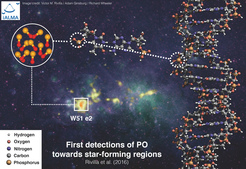First detections of the key prebiotic molecule PO in star-forming regions
An international group of scientists from the Arcetri Astrophysical Observatoryin Florence, the Center of Astrobiology in Madrid and the Max-Plank Institute for Extraterrestrial Physics has detected for the first time the prebiotic molecule PO in star-forming regions. This molecule plays a key role in the double helix structure of DNA, and is therefore directly linked to the origin of life in the Universe.
In the past few years, the new generation of telescopes has allowed the astronomers to detect in the interstellar medium molecules that play an important role in prebiotic chemistry. These molecules are considered the building blocks of the first living organisms, and therefore their study can shed light on the origin of life in the Universe.

Several molecular species have been identified by the astronomers (methanol, methyl formate…) in gas clouds in space. Now the key prebiotic molecule PO was detected for the fist time in the star-forming regions W51 e1/e2 and W3(OH).
One of the key elements for the development of life is phosphorus (P). Chemical compounds containing phosphorus are essential for the structure of and energy transfer in cells. Especially important is the chemical bond between phosphorus and oxygen, PO, which is crucial for the formation of the backbone of the deoxyribonucleic acid, DNA, the macromolecule that contains the generic information of living organisms.
“Despite its astrobiological relevance, the PO molecule had not been previously detected in the regions where stars are formed”, says Víctor M. Rivilla, an astronomer of the Arcetri Observatory in Florence (INAF-OAA). “We were very interested in finding this molecule in the cradle of stars, because this would mean that one of the basic pieces of the DNA is already available in the gas that will form the planets where life may originate. So we started a project to search for PO in star-forming regions”.
Indeed, the astronomers have recently detected the prebiotic molecule PO for the first time in two star-forming regions in our galaxy: W51 e1/e2 and W3(OH). This important discovery has been accepted for publication in The Astrophysical Journal. The observations were carried out with the 30m-size radio telescope of the Institute of Radioastronomie Millimetrique (IRAM) located in Pico Veleta (Granada, Spain). The results of this work indicate that the abundance of phosphorus in star-forming regions is more than ten times higher than previously thought.

''While large organic molecules in space attract a lot of attention as building blocks of life, there is a simple molecule which plays an important role in shaping the structure of the genetic code carrier DNA: PO. In fact, sugar-phosphate groups, which include PO bonds, hold together the spiral staircase within DNA,” explains Anton Vasyunin from the Center for Astrochemical Studies (CAS) at MPE. In the CAS group, the scientists are working on understanding how simple as well as complex molecules – the building blocks of life - form and evolve in the interstellar medium. “Our chemical models are crucial to interpret observations and we have applied them to this new detection of PO,” Vasyunin points out. “We found that the production of PO becomes efficient in the vicinity of newly born stars, which warm up their surrounding parental cloud. Our models well match the observations."
Paola Caselli, coauthor of the work and Director of the Center for Astrochemical Studies at MPE is excited: “This discovery is a groundbreaking result. The search for prebiotic molecules in star-forming regions is still in its infancy but another building block of life has now been found and this brings more excitement to the field of astrochemistry. The future is bright, thanks to great instruments such as the IRAM telescopes and the Atacama Large Millimeter/Submillimeter Array (ALMA) available nowadays”.
“This study is telling us that phosphorus is an important and relatively abundant ingredient to ‘cook’ stars, planets and maybe also life”, says Francesco Fontani (INAF-OAA), coauthor of the work. “Some years ago, we already discovered the presence of the simplest sugar in a star-forming region, glycolaldehyde. Both sugars and compounds with phosphorus are the building blocks of the double helix of DNA”, adds Maite Beltrán (INAF-OAA), coauthor of the work. “Therefore, step by step, our findings are helping us to understand how life could be originated in space”.
These first detections of the PO chemical bond towards star-forming regions have profound implications for the prebiotic chemistry. “So far only molecules containing hydrogen, carbon, oxygen and nitrogen had been studied in detail in star-forming regions. After our discoveries we can now start to study the chemistry of phosphorus in the interstellar medium, which will give us important clues about how the chemical complexity can grow to form more complex molecules with astrobiological relevance”, says Jesús Martín-Pintado (CAB-CSIC), coauthor of the work.













